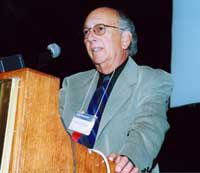 "Messages should be pretested for their effectiveness and appropriateness to the target audience." - Dr. Joseph Cappella, University of Pennsylvania, Philadelphia.
"Messages should be pretested for their effectiveness and appropriateness to the target audience." - Dr. Joseph Cappella, University of Pennsylvania, Philadelphia.A review of current, effective drug abuse prevention programs and the announcement of a new NIDA initiative were among the highlights of the Second National Conference on Drug Abuse Prevention Research held August 9 and 10 in Washington, D.C. Almost 900 participants from all 50 States, the District of Columbia, Puerto Rico, and 13 foreign countries attended the meeting, which was sponsored by NIDA and the Robert Wood Johnson Foundation.
"A particular focus of this conference is to examine how prevention programs can be implemented at the local level," said Dr. Elizabeth Robertson, chief of NIDA's Prevention Research Branch.
"In 20 years of research, we have learned that there are modifiable risk and protective factors, particular points of vulnerability to drug use and abuse, and some basic prevention principles which we summarized in the first-ever science-based guide to prevention, Preventing Drug Use Among Children and Adolescents," said then NIDA Director Dr. Alan I. Leshner in his remarks to participants. "Research has answered many questions, but others remain. We now target risk and protective factors in our prevention programs, but what are the factors that influence the actual decision to use drugs?
"Over the next 2 years, NIDA will establish the National Drug Abuse Prevention Research Initiative," said Dr. Leshner. "Our goal is to provide the resources to bring the full power of science to bear on the challenge of developing effective drug abuse prevention programs. The Initiative will have three components: Basic Prevention Science Research, Transdisciplinary Prevention Research Centers (TPRCs) and Community Multisite Prevention Trials."
The initiative is intended to stimulate research to translate new knowledge into new interventions, Dr. Leshner noted. The Basic Prevention Science Research component will examine ideas from the sociological, biological, behavioral, and cognitive literature, looking for new information with the potential to inform the development and pilot-testing of new prevention interventions. The TPRCs will support collaborative projects by basic, applied, and clinical researchers across the country. They will focus on identifying and addressing the major knowledge gaps that affect the work of State and local prevention service providers.
The Multisite Trials will test the effectiveness of drug abuse prevention programs in diverse populations and locations. "The trials will examine the features that influence the successful adoption, adaptation, sustainability, and outcomes of science-based interventions in large-scale field trials," Dr. Leshner said.
 "We must reduce the risk factors and promote the development of protective factors on all levels: individual, family, peers, school, and community." - Dr. David Hawkins, University of Washington, Seattle.
"We must reduce the risk factors and promote the development of protective factors on all levels: individual, family, peers, school, and community." - Dr. David Hawkins, University of Washington, Seattle.The conference also featured panel discussions on using risk and protective factors in prevention, identifying effective features in prevention interventions, assessing substance abuse in the community, and building multicomponent community programs. Small-group workshops and lunchtime discussion groups gave participants an opportunity to learn about particular programs in detail and share lessons learned in their own communities.
Risk and Protective Factors
Dr. David Hawkins of the Social Development Research Group at the University of Washington in Seattle summarized the risk and protective factors that can influence whether young people will use drugs. "Over the last 20 years, longitudinal studies have identified many factors that predict youth violence, substance abuse, and other problem behaviors," he said. "Such factors exist in every domain of life: individual, family, peers, school, and community. We must reduce the risk factors and promote the development of protective factors on all levels: individual, family, school, peer, and community." (See "Risk and Protective Factors in Drug Abuse Prevention.") There is a growing list of tested, effective prevention programs that have been shown to reduce risks, enhance protection, and prevent adolescent substance abuse, Dr. Hawkins noted.
Dr. Sheppard Kellam of the American Institutes for Research in Washington, D.C., discussed a school-based intervention called the "Good Behavior Game (GBG)." Previous research has shown that aggressive and disruptive behavior among first-graders is associated with later aggression, violence, drug abuse, and school dropout. The GBG was originally developed in the late 1960s to help teachers organize and manage classroom behavior and to teach young children how to behave as students. Accepting rules of classroom behavior, concentrating and being ready to work, participating appropriately in classroom teaching and with classmates, and learning were the focus of the GBG. In 1985-1986, Dr. Kellam and his colleagues implemented the GBG as a prevention intervention in 40 first-grade classrooms in 18 representative elementary schools in Baltimore.
First- and second-grade children were assigned to one of three teams in their classroom. During the game, teams were penalized if any team member did not follow the rules, for example, by speaking out of turn or getting out of their seats without permission. Teams with four or fewer penalties at the end of the game were rewarded with verbal praise from the teacher, special snacks, or extra time at recess; teams with more than four penalties were not rewarded. At first, the game was played three times a week for 10 minutes at a time. The length of time the game was played increased until it reached a weekly maximum of 3 hours.
 "Previous research has shown that aggressive and disruptive behavior among first-graders is associated with later aggression, violence, drug abuse, and school dropout." - Dr. Sheppard Kellam, American Institutes for Research, Washington, D.C.
"Previous research has shown that aggressive and disruptive behavior among first-graders is associated with later aggression, violence, drug abuse, and school dropout." - Dr. Sheppard Kellam, American Institutes for Research, Washington, D.C. Six years later, preliminary analysis of followup data revealed that aggressive behavior and smoking initiation were lower among children who received the classroom intervention compared to those who had not, particularly among boys who had been disruptive or aggressive in first grade. In a recent followup of the participants at age 19 to 22, preliminary analyses indicate that the prevalence of antisocial personality disorder among the most aggressive boys appears to be three to four times lower compared to aggressive boys who did not receive the intervention. These results underscore the importance of early socializing children into the role of student, particularly those at increased risk of learning and/or behavioral problems.
Implementation of Interventions
Dr. Linda Dusenbury of Tanglewood Research, Inc., in Greensboro, North Carolina, discussed the effective implementation of interventions. She noted that effective programs are research-based and typically include social resistance training to help students refuse offers to use drugs, as well as information that counters their erroneous perceptions that drug use is widespread among their peers. Effectiveness also depends on the "dosage" -- how much of a program is delivered -- and the quality -- how well the program is delivered, she said. "Ineffective prevention strategies include scare tactics and moral messages," Dr. Dusenbury said. "An exclusive focus on information about different drugs and testimonials from recovering addicts doesn't work very well, either."
 "We will examine how prevention programs can be implemented at the local level." - Dr. Elizabeth Robertson, chief of NIDA's Prevention Research Branch.
"We will examine how prevention programs can be implemented at the local level." - Dr. Elizabeth Robertson, chief of NIDA's Prevention Research Branch.Dr. Dusenbury noted that when programs are implemented, there is always a tension between fidelity to the program as it was originally designed and the flexibility required to adapt it to local needs. "If some aspect of a particular program is not working in your community and you want to change it, it's best to talk to the people who developed the program to make sure your adaptation does not violate key principles of the program," Dr. Dusenbury said. "This step helps you and provides the developers with useful feedback."
Dr. Christopher Ringwalt of the Pacific Institute for Research and Evaluation in Chapel Hill, North Carolina, reported preliminary results of a study to identify the prevention curricula being used in middle schools and junior high schools across the country and to determine how many schools were using research-based curricula. Data were collected in 1999 from 1,905 public and private schools via a questionnaire filled out by school staff who taught substance abuse prevention classes.
The study found that only 25 percent of the schools surveyed used at least one research-based curriculum. Respondents were more likely to use didactic instruction methods such as lectures and classroom discussions than interactive methods such as small-group discussions and role-playing activities when presenting information.
The most frequently emphasized content area was knowledge of drugs and their effects; the least emphasized area was drug refusal skills. "These results demonstrate a considerable gap between current school prevention practices and our understanding of effective curricula and their components," said Dr. Ringwalt.

Mass Media Campaigns
An overview of the key elements that make mass media campaigns effective was presented by Dr. Joseph Cappella of the Annenberg School of Communication at the University of Pennsylvania in Philadelphia. He began by noting that success is contingent upon clearly defining a target audience, understanding their prevailing attitudes and beliefs, and crafting engaging and persuasive messages that are presented over the long term. These messages should be pretested for their effectiveness and appropriateness to the target audience.
Well-designed campaigns, Dr. Cappella noted, can affect behavior, as demonstrated by research on smoking and drug use among teens. For example, an anti-marijuana public service announcement (PSA) campaign developed by NIDA-supported researchers at the University of Kentucky in Lexington decreased marijuana use by more than 25 percent among high-sensation-seeking adolescents -- a group particularly at risk for drug abuse. (See "Television Public Service Announcements Decrease Marijuana Use in Targeted Teens.") The PSAs included messages especially designed to appeal to the sensation-seeking teens and ran for 4 months during TV programs popular with this group.